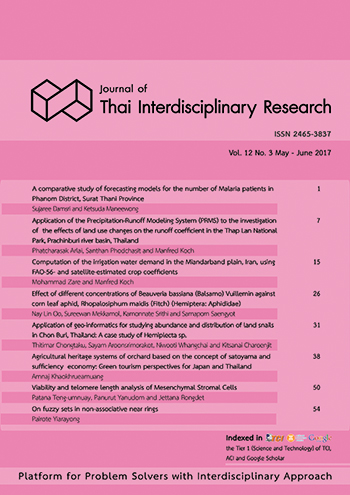Computation of the irrigation water demand in the Miandarband plain, Iran, using FAO-56- and satellite-estimated crop coefficients
Main Article Content
Abstract
Irrigation water requirement (IWR) is defined by the difference of the evapo-transpired water of an agricultural plant/crop and the effectively available precipitation. IWR is thus an important parameter in arid and semi-arid areas for the set-up of optimal irrigation planning and scheduling strategies. Obviously, the major step to estimate IWR, is the evaluation of the crop evapotranspiration (ETc) of the totality of the cultivated crops in an area. The FAO-56 or FAO-Penman-Monteith (FAO-PM) model is usually used to that avail, wherefore the standard reference (PM- computed) evapotranspiration (ETo) is calculated by its crop coefficient Kc, an empirical parameter, which depends also on the crop’s seasonal growth stage. In recent years, ETc- calculations on the regional scale that are based on the use of remotely sensed vegetation indices (VI), called Kc (VI), have increasingly been used. In this study, two kinds of VIs, namely, the normalized vegetation index (NDVI) and the soil adjusted vegetation index (SAVI) have been estimated from reflectance images for six passes of the Landsat 8 satellite over the Miandarband flood plain, Iran, in the three summer months of 2015 and 2016 and then been used to compute linear relationships of Kc (NDVI) and Kc (SAVI). The ETc and IRW obtained with these satellite- based crop-coefficients are compared with those obtained with the empirical Kc’s of the classical FAO-56 method. Although there is a general good agreement for the long-term FAO- and satellite-estimated ETc and IWR for the months analysed, the remote sensing approach hints of some extension of the total crop cultivated area in the Miandraband plain beyond the originally recommended area in the wet year 2015-2016.
Article Details
How to Cite
Zare, M., & Koch, M. (2017). Computation of the irrigation water demand in the Miandarband plain, Iran, using FAO-56- and satellite-estimated crop coefficients. Interdisciplinary Research Review, 12(3), 15–25. https://doi.org/10.14456/jtir.2017.16
Section
Research Articles


